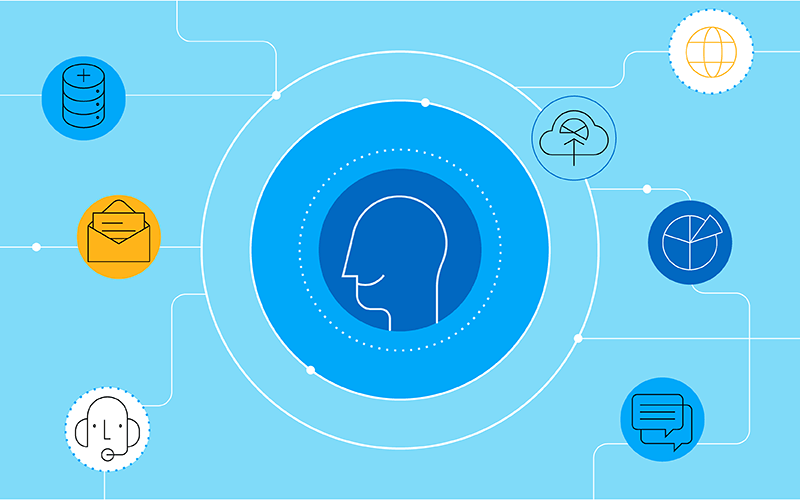6 Personalization Challenges Explained

The world of digital marketing keeps evolving incredibly fast. So do the customer demands and we all need to make sure we keep up. In this blog post, we take a look at the major shifts and challenges that organizations need to be prepared for to make sure their personalization efforts don’t go to waste.
Advances in technology, data collection and analysis are allowing marketers to craft even more relevant and personal experiences at every juncture. Accordingly, today’s empowered and tech-savvy consumers now feel entitled to seamless and personalized customer experiences. And while personalization is always in demand and these potential wins seem exciting, most marketers and IT teams today feel underprepared to meet the challenges in a dynamic business and technological landscape. Let’s take a closer look at a few reasons why nailing personalization is no easy feat and some solutions to help your organization address these problems.
Data Collection and Silos
Personalization starts with data. It is safe to say that data is the only instrument you have to achieve a credible level of convenience, relevance, speed and timing to drive repeat visits, purchases and engagement. And when it comes to personalization, context is everything. Having an abundance of quality data is what leads marketers to make their best decisions possible. In recent years, the quality, not the quantity of data has become one of the biggest obstacles to having a sustainable personalization strategy, along with building a data architecture and integrating third-party sources.
And, as the customer journey grows increasingly more complex and non-linear, the data about your customers, their background, attitudes, needs, wants, behaviors, and context of interaction—is all spread across a host of channels, platforms, and systems and stored in a number of silos. The reason is that as consumer adoption of new technologies and channels accelerated, companies had to quickly catch up with these new touchpoints—social channels, devices and mobile apps—as fast as possible. As most brands did this in a rush and without a clear vision, they failed to integrate these channels and their underlying data. As a result, their data is hard to work with, convoluted, repetitive across databases, and never complete.
You not only need to capture all this data, but to integrate and leverage it to create a more holistic picture of each customer. Data silos negatively impact every type of customer communication, whether that’s the onboarding of new customers, encouraging upsales, service messaging or re-engagement campaigns. Fundamentally, silos limit your ability to run effective multichannel campaigns and at worst, lead to impersonal and irrelevant customer experiences.
“We predict that through 2020, silos of customer engagement will be one of the top three leading causes of customer dissatisfaction for enterprises across all industry segments.”
—Gartner
The solution lies in the proper integration and sharing of data within a set of standards across diverse systems, so that they talk to each other and organizations understand their customers better and provide seamless user experiences. A necessary first step is performing a data audit to analyze what data you collect and what you don’t and where and then implementing a data governance strategy to make sure the data you accumulate if properly stored, accurate, uniform, and consistent.
Complete Customer Profile
Having an ocean of mix-and-match data does not quite help identify common threads and patterns across channels and touchpoints. To build a better picture of who the customer really is, marketers need to piece together their customer data coming from diverse sources and engagement systems into a comprehensive customer profile. A profile needs to aggregate and provide a consistent, detailed and all-round view of the customer to everyone in the organization and allow a deep understanding of past behaviors, current context and proper planning of future customer interactions.
This sort of all-encompassing data collected for every customer, combined with machine learning and omnichannel orchestration, constitute the foundation of a modern marketing technology infrastructure that facilitates cross-functional management to deliver personalized customer experiences through a single point of control over data, decisions and interactions. The single customer view is especially relevant where organizations engage with customers through multiple channels, since customers expect those interactions to reflect a consistent understanding of their history and preferences.

Organizations need to take the next step beyond anonymous visitor data, stored in silos, and properly organize and leverage the obtained information to map demographic, behavioral and context-rich awareness of the needs and interests that power personalized, relevant offers and experiences. Navigating through the ocean of big data coming from web, mobile, social, email, wearables, and in-person channels is a challenge, but it is only the aggregation of this data that can bring you closer to a 360-degree customer understanding and experience.
Following are a few fundamental points that are required for having the proper data in the proper place and, consequently a comprehensive customer profile:
- Unified login and registration process across digital properties to recognize and map visitors to profiles
- Data and analytics capabilities to mine customer data for targeted insights
- Customer profile data management capabilities to collect, store, manage, and analyze customer profile data
With a focus on seamlessly connecting strategy, management and customer value, an organization can provide optimized and hyper-personalized customer experiences in real time, free of friction across journey stages and touchpoints. As personalization depends on a very deep understanding of the customer—their needs, preferences, behavior, choices, demographics and socio-economic information—disconnected channels, systems, and applications must come together to create a single source of truth of reliable customer data to deliver relevancy and personalization.
Organizational Silos
Data silos usually occur not just because the customer journey is getting more complex. As businesses expand, so does their need to scale and grow their teams to manage their workload in a consistent way. Teams and departments work with diverse information, analytics, CRM, marketing automation, storage, and other third-party systems that meet specific needs. Data is fragmented, it’s not available to all applications, and the lack of common standards makes it difficult to communicate and merge the data across applications. Thus, the potential roadblock lies not just in data collection, but in organizational alignment, goal sharing, and continuous communication.
Keep in mind that for a prospect or customer, your company is one unified entity even though on the inside different teams may be responsible for different channels or parts of the customer journey and each team works on optimizing customer experiences independently of each other. Your customers do not care about your internal structure and data silos. They simply demand a frictionless and dynamic experience without the hassle of reiterating their preferences at different touchpoints as they go through a complex user journey.
As organizations struggle to catch up with personalization trends, they need to reorganize their structures to avoid data, organizational and technological silos. To avoid inconsistent messaging, value propositions, and ultimately poor user experience and personalization results, your marketing, sales, and customer success departments need to work together and align on the personalization strategy and tactics. As a result, there is no disorganization in personalization efforts, and the common goals and KPIs trickle down to each and every team as they work in collaboration to drive results
Tech Stack
For many marketers, harnessing the sheer power of cutting-edge technology will result in forging an everlastingly engaging experience with customers. As the needs and context of every prospect and customer vary, companies can now see, understand and act upon these variations of experiences. However, the magical wand of the latest tech does not automatically guarantee frictionless omni-channel interactions, personalized content, and consistently reaching the right audience at the right moment.
So, how do you know whether you have the right tools and technology to make sure you track, capture, and leverage all the data that is created every time a customer interacts with your brand? The reality is that each time marketers had to manage yet another channel, most probably an additional technology was put in place to support it. It all started with a single website, sprawled over multiple web properties, then to email marketing, search, display, social media, and mobile. Accordingly, customers have come to demand from companies to do just that—provide the seamless experience, no matter when and where it occurs.
As with personalization where no one-size-fits-all message exits, same goes with martech (marketing technology) stacks—your business, needs, and requirements impact which technologies you might find important, and how they need to be organized. Therefore, organizations need to have a clear vision of their goals and, consequently, strategy, to be able to select and build the proper martech stack. Such a stack will enable them to execute, analyze, and improve their marketing across the customer lifecycle, as well as improve internal collaboration, measure the impact of marketing activities, and reach customers in new ways. The ability to manage and get the most out of marketing tooling is the key to success with contextualized marketing with analytics-driven initiatives that touch known customers on a personal level.

There are, however, a few technologies that are fundamental to your marketing technology stack as you begin to build it. Make sure you have the following key technologies in place and in sync:
- Data management
Uses data from diverse sources to identify and characterize visitors for focused targeting - Content management
Enables marketers to create and manage digital content and assets hassle-free and then use this content for targeted initiatives across the board - Digital experience and personalization layer
Targets audiences with personalized messaging across channels through the management of audiences, relationships, campaigns, and workflow. Delivers personalized content to consumers at the right time, place, and context via the most appropriate channels.
- Analytics performance reporting
Measures the outcomes of specific actions and marketing initiatives across channels and feeds the information and feeds the information back to data management to close the loop - Predictive analytics engine
Uses advanced analytics, predictive modeling and next-best-action action capabilities to understand visitor preferences and predict behavior to optimize results
Delivering personalized experiences at scale requires audience management, which facilitates the creation of comprehensive customer profiles. Backend systems such as CRM, ERP, and other digital marketing solutions contain a wealth of customer information such as recent purchases, location, demographics, and product interests. Customer data can be further enhanced with details about how consumers are interfacing with a brand’s websites, mobile applications, and other company-owned channels. Additionally, Marketing Automation Systems (MAS) facilitate effective marketing personalization across multiple channels, such as email, social media, and websites.
But for the brands setting the personalization standard, they know they must turn massive and potentially unwieldy data into dynamic, highly-relevant insights. That’s why they use predictive models that allow them to target and deliver one-to-one content and experiences. And they rely on technology—especially artificial intelligence and machine learning—to support advanced decisioning capabilities to drive their targeting. AI-powered systems have made it possible to predict possible paths consumers might take. AI systems that are continuously learning and adapting to the latest user context can radically transform how a marketer leverages predictive models and data science to effectively segment and target known customers at scale.
The right tools are crucial for translating data into effective personalization. Without technology that is both dynamic and not too complex, marketers are unable to leverage all the volumes of data created at every step a customer takes, nor can automation foster the seamless and personalized brand experience that marketers need to offer.
Content Management and Scalability
While the right technology is crucial for successful personalization initiatives, implementing personalization across channels can be a formidable task. Even when organizational silos are mitigated, not all companies are prepared to dedicate the time and resources toward a successful personalized marketing strategy, so they need to make sure they have the personalization mindset from the get-go.
One of the most notable barriers to achieving personalization at scale is taking the time and effort to craft, assemble, and deliver the demanding amounts of personalized content variations tailored for different individuals and user journeys. As the level of sophistication of your digital marketing grows, you not only see an increase of traffic and have to account for it with scalability, you also see increases in the number of users who create those experiences. It’s one thing to personalize one page for one segment, but it’s a completely different thing when you have five personas, six geographies, eight divisions, 20 sites and 1,000 different assets you want to personalize. When you get to that point, you need structure. In fact, lack of structure is one of the biggest reasons why so few organizations get personalization right today.
Additionally, dependence on IT and development teams to make small changes, implement personalization tactics, and sync content impedes the shorter content cycles and fast response in delivering personalization campaigns and experiences. It is not uncommon for marketing to have to rely on IT and development to help, because they lack the knowledge and technology that would enable them to do it themselves. These hand-offs and wait times slow down and impede marketing’s ability to deliver true personalized experiences.
Content teams need to have a platform in place that streamlines and facilitates the process of content creation, collaboration, and delivery of omnichannel personalization at scale. This platform should allow marketing to seamlessly optimize content and messaging and execute strategy that achieves business KPIs, without reliance on IT. Additionally, marketing teams need to be able to experiment with and validate the impact of content changes by deploying personalized, targeted variations of content.

Regulations and Restrictions
As new regulations on data privacy come into the spotlight, marketers fear that their most valued resource that is at the core of a great personalized experience—data—is getting harder to obtain. How do you get to know your audience better unless you track and collect data? While this may be true, as with any potential roadblock, you have to look at it as an opportunity. Regulations may include the EU-bound GDPR, HIPAA, CCPA, and other restrictions on location data collection. The trend is clear: The collection and use of personal data is coming under increased scrutiny, which can significantly impact personalized marketing strategies.
It is important to note that data regulations, including the notorious GDPR, do not restrict you from collecting data. They are in place to make sure no private data is collected without consent or using dishonest practices. Such restrictions put control in the hands of the prospects and customers and they typically do consent to share their information but only for a good reason. That starts through a transparent and ongoing dialogue—it is not about just collecting data but ensuring that the information is accurate and acquired in a transparent manner that customers are comfortable with. Personalized marketing works if marketers are willing to put in the effort.
Consequently, your opportunity lies in keeping your customers at the center of your efforts and willing to be honest and open how you use personal data—to deliver value, good experiences, and foster loyalty, transparency, and trust. This ultimately turns the wheel and customers share even more data to receive even more relevant customer experiences.
A few points to consider along the way:
- Always notify users before tracking cookies
To get users to agree to cookie tracking, emphasize the benefits of opting in, like you would on a post-click landing page - Only collect what you need
Do not go over the top with long forms—the best number of fields to use is the fewest that you need to provide the best service possible - Minimize data handling personnel
Make sure personal data is handled only by the people who need it to carry out the processing

Moving beyond GDPR, privacy requirements will actually help to drive better customer experiences as organizations will only be able to use relevant and up to date information to individualize customer experience. It will also require them to explain how individualization is made possible, and sell the value of it, creating better customer relationships based on transparency and trust.
Make Personalization Work with Sitefinity
Success in a new era of personalization requires martech organizations to plan, structure and align around the customer. Sitefinity provides the right tools, technology and approach to deliver a consistent and persistent customer journey. It is the platform that enables and empowers you to expertly craft digital experiences and helps you address the key challenge areas—content management at scale, audience management, omnichannel support, integration of key applications and data, compliance with regulations and standards by:
- Collecting data across systems
- Building an all-encompassing contact profile
- Producing analysis and ML-driven analytics insights
- Delivering personalized experiences at scale
- Enabling marketing for digital optimization
Want to know more about where the industry stands and what the key challenges are in 2020 and beyond? The Evolution of Digital Experience is the first-of-its-kind global survey of more than 900 business leaders, web and app development leaders across digital experience, application development and business demands.

Petra Lazarova
Petra Lazarova was part of the Sitefinity Product Marketing team.
